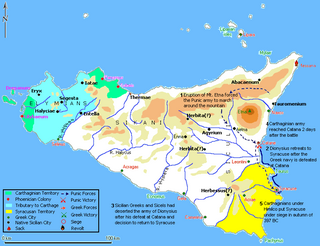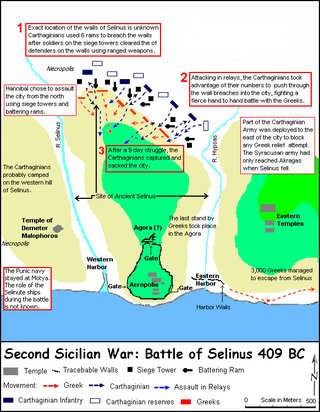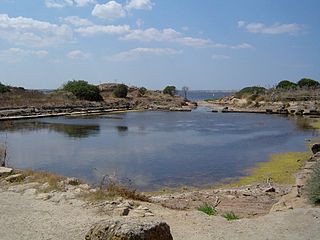Related Research Articles

The Battle of Himera, supposedly fought on the same day as the Battle of Salamis, or at the same time as the Battle of Thermopylae, saw the Greek forces of Gelon, King of Syracuse, and Theron, tyrant of Agrigentum, defeat the Carthaginian force of Hamilcar the Magonid, ending a Carthaginian bid to restore the deposed tyrant of Himera. The alleged coincidence of this battle with the naval battle of Salamis and the resultant derailing of a Punic-Persian conspiracy aimed at destroying the Greek civilization is rejected by modern scholars. Scholars also agree that the battle led to the crippling of Carthage's power in Sicily for many decades. It was one of the most important battles of the Sicilian Wars.

The Battle of the Crimissus was fought in 339 BC between a large Carthaginian army commanded by Asdrubal and Hamilcar and an army from Syracuse led by Timoleon. Timoleon attacked the Carthaginian army by surprise near the Crimissus river in western Sicily and won a great victory. When he defeated another much smaller force of Carthaginians shortly afterwards, Carthage sued for peace. The peace allowed the Greek cities on Sicily to recover and began a period of stability. However, another war between Syracuse and Carthage erupted after Timoleon's death, not long after Agathocles seized power in 317 BC.

The siege of Syracuse in 397 BC was the first of four unsuccessful sieges Carthaginian forces would undertake against Syracuse from 397 to 278 BC. In retaliation for the siege of Motya by Dionysius of Syracuse, Himilco of the Magonid family of Carthage led a substantial force to Sicily. After retaking Motya and founding Lilybaeum, Himilco sacked Messana, then laid siege to Syracuse in the autumn of 397 BC after the Greek navy was crushed at Catana.

The Sicilian Wars, or Greco-Punic Wars, were a series of conflicts fought between ancient Carthage and the Greek city-states led by Syracuse over control of Sicily and the western Mediterranean between 580 and 265 BC.

The city of Carthage was founded in the 9th century BC on the coast of Northwest Africa, in what is now Tunisia, as one of a number of Phoenician settlements in the western Mediterranean created to facilitate trade from the city of Tyre on the coast of what is now Lebanon. The name of both the city and the wider republic that grew out of it, Carthage developed into a significant trading empire throughout the Mediterranean. The date from which Carthage can be counted as an independent power cannot exactly be determined, and probably nothing distinguished Carthage from the other Phoenician colonies in Northwest Africa and the Mediterranean during 800–700 BC. By the end of the 7th century BC, Carthage was becoming one of the leading commercial centres of the West Mediterranean region. After a long conflict with the emerging Roman Republic, known as the Punic Wars, Rome finally destroyed Carthage in 146 BC. A Roman Carthage was established on the ruins of the first. Roman Carthage was eventually destroyed—its walls torn down, its water supply cut off, and its harbours made unusable—following its conquest by Arab invaders at the close of the 7th century. It was replaced by Tunis as the major regional centre, which has spread to include the ancient site of Carthage in a modern suburb.
Mago was commander of the Carthaginian fleet under Himilco in the war against Dionysius I of Syracuse, 396 BCE.

The Battle of Selinus, which took place early in 409 BC, is the opening battle of the so-called Second Sicilian War. The ten-day-long siege and battle was fought in Sicily between the Carthaginian forces under Hannibal Mago and the Dorian Greeks of Selinus. The city of Selinus had defeated the Elymian city of Segesta in 415, an event that led to the Athenian invasion of Sicily in 415 and ended in the defeat of Athenian forces in 413. When Selinus again worsted Segesta in 411, Carthage, responding to the appeal of Segesta, had besieged and sacked Selinus after the Carthaginian offer of negotiations had been refused by the Greeks. This was the first step towards Hannibal's campaign to avenge the Carthaginian defeat at the first battle of Himera in 480. The city of Selinus was later rebuilt, but never regained her former status.

Near the site of the first battle and great Carthaginian defeat of 480 BC, the Second Battle of Himera was fought near the city of Himera in Sicily in 409 between the Carthaginian forces under Hannibal Mago and the Ionian Greeks of Himera aided by an army and a fleet from Syracuse. Hannibal, acting under the instructions of the Carthaginian senate, had previously sacked and destroyed the city of Selinus after the Battle of Selinus in 409. Hannibal then destroyed Himera which was never rebuilt. Mass graves associated with this battle were discovered in 2008-2011, corroborating the stories told by ancient historians.

The siege of Akragas took place in 406 BCE in Sicily; the Carthaginian enterprise ultimately lasted a total of eight months. The Carthaginian army under Hannibal Mago besieged the Dorian Greek city of Akragas in retaliation for the Greek raids on Punic colonies in Sicily. The city managed to repel Carthaginian attacks until a relief army from Syracuse defeated part of the besieging Carthaginian army and lifted the siege of the city.

The Battle of Gela took place in the summer of 405 BC in Sicily. The Carthaginian army under Himilco, which had spent the winter and spring in the captured city of Akragas, marched to confront the Greeks at Gela. The Syracuse government had deposed Daphnaeus, the unsuccessful general of the Greek army at Akragas, with Dionysius, another officer who had been a follower of Hermocrates. Dionysius schemed and gained full dictatorial powers.

The siege of Motya took place in summer 398 BC in western Sicily. Dionysius, after securing peace with Carthage in 405 BC, had steadily increased his military power and had tightened his grip on Syracuse. He had fortified Syracuse against sieges and had created a large army of mercenaries and a large fleet, in addition to employing the catapult and quinqueremes for the first time in history. In 398 BC, he attacked and sacked the Phoenician city of Motya despite the Carthaginian relief effort led by Himilco. Carthage also lost most of her territorial gains secured in 405 BC after Dionysius declared war on Carthage in 398 BC.
The Battle of Messene took place in 397 BC in Sicily. Carthage, in retaliation for the attack on Motya by Dionysius, had sent an army under Himilco, to Sicily to regain lost territory. Himilco sailed to Panormus, and from there again sailed and marched along the northern coast of Sicily to Cape Pelorum, 12 miles (19 km) north of Messene. While the Messenian army marched out to offer battle, Himilco sent 200 ships filled with soldiers to the city itself, which was stormed and the citizens were forced to disperse to forts in the countryside. Himilco later sacked and leveled the city, which was again rebuilt after the war.

The Battle of Catana took place in the summer of 397 BC. The Greek fleet under Leptines, the brother of Dionysius I of Syracuse, engaged the Carthaginian fleet under Mago near the city of Catana in Sicily. While the Greek army under Dionysius was present near the city of Catana during the battle, the Carthaginian army under Himilco was away in the interior of Sicily, making a detour around the erupting Mount Etna. The Carthaginian fleet crushed the Greek fleet in the battle, leading to the Carthaginian siege of Syracuse later in 397 BC.
The Battle of Abacaenum took place between the Carthaginian forces under Mago and the Siceliot army under Dionysius in 393 BC near the Sicilian town on Abacaenum in north-eastern Sicily. Dionysius, tyrant of Syracuse, had been expanding his influence over Sicels' territories in Sicily. After Dionysius' unsuccessful siege in 394 BC of Tauromenium, a Carthaginian ally, Mago decided to attack Messana. However, the Carthaginian army was defeated by the Greeks near the town of Abacaenum and had to retire to the Carthaginian territories in Western Sicily. Dionysius did not attack the Carthaginians but continued to expand his influence in eastern Sicily.
The siege of Tauromenium was laid down by Dionysius, tyrant of Syracuse, in the winter of 394 BC, in the course of the Sicilian Wars against Carthage. After defeating the Carthaginians at the Battle of Syracuse in 397 BC, Dionysius had been expanding his territory and political influence by conquering Sicel lands and planting Greek colonies in northeastern Sicily. Tauromenium was a Sicel city allied to Carthage and in a position to threaten both Syracuse and Messina. Dionysius laid siege to the city in the winter of 394 BC, but had to lift the siege after his night assault was defeated. Carthage responded to this attack on their allies by renewing the war, which was ended by a peace treaty in 392 BC that granted Dionysius overlordship of the Sicels, while Carthage retained all territory west of the Halykos and Himera rivers in Sicily.
Himilco was a member of the Magonids, a Carthaginian family of hereditary generals, and had command over the Carthaginian forces between 406 BC and 397 BC. He is chiefly known for his war in Sicily against Dionysius I of Syracuse.
The siege of Segesta took place either in the summer of 398 BC or the spring of 397 BC. Dionysius the Elder, tyrant of Syracuse, after securing peace with Carthage in 405 BC, had steadily increased his military power and tightened his grip on Syracuse. He had fortified Syracuse against sieges and had created a large army of mercenaries and a large fleet, in addition to employing catapults and quinqueremes for the first time in history. In 398 BC he attacked and sacked the Phoenician city of Motya despite a Carthaginian relief effort led by Himilco II of Carthage. While Motya was under siege, Dionysius besieged and assaulted Segesta unsuccessfully. Following the sack of Motya, Segesta again came under siege by Greek forces, but the Elymian forces based in Segesta managed to inflict damage on the Greek camp in a daring night assault. When Himilco of Carthage arrived in Sicily with the Carthaginian army in the spring of 397 BC, Dionysius withdrew to Syracuse. The failure of Dionysius to secure a base in western Sicily meant the main events of the Second Sicilian war would be acted out mostly in eastern Sicily, sparing the Elymian and Phoenician cities the ravages of war until 368 BC.
The siege and subsequent sacking of Camarina took place in 405 BC during the Sicilian Wars.

The siege of Syracuse from 344 to 343/342 BC was part of a war between the Syracusan general Hicetas and the tyrant of Syracuse, Dionysius II. The conflict became more complex when Carthage and Corinth became involved. The Carthaginians had made an alliance with Hicetas to expand their power in Sicily. Somewhat later, the Corinthian general Timoleon arrived in Sicily to restore democracy to Syracuse. With the assistance of several other Sicilian Greek cities, Timoleon emerged victorious and reinstated a democratic regime in Syracuse. The siege is described by the ancient historians Diodorus Siculus and Plutarch, but there are important differences in their accounts.
References
- 1 2 Diodorus Siculus, X.IV.95
- ↑ Church, Alfred J., Carthage, p. 47
- ↑ Caven, Brian, Dionysius I, p. 107
- ↑ Diodorus Siculus X.IV.55
- ↑ Kern, Paul B., Ancient Siege Warfare, p. 183
- ↑ Freeman, Edward A., Sicily, p. 173
- ↑ Freeman, Edward A. Sicily, p. 173
- 1 2 3 Church, Alfred J., Carthage, pp. 53-54
- ↑ Lancel, Serge, Carthage A History, p. 114
- ↑ Freeman, Edward A., History of Sicily Vol IV, p. 169
- 1 2 3 Diodorus Siculus, X.IV.90
- ↑ Freeman, Edward A., History of Sicily Vol. 4 pp. 58–59
- ↑ Diodorus Siculus X.IV.90
- 1 2 3 4 Diodorus Siculus, X.IV.88
- ↑ Freeman, Edward A. History of Sicily Vol. 4 pp. 149–151
- ↑ Polyainos V.2.1
- 1 2 Diodorus Siculus, X.IV.78
- ↑ Freeman, Edward A. History of Sicily Vol. 4 pp. 18–21
- ↑ Freeman, Edward A. History of Sicily Vol. 4 p. 107
- ↑ Diodurus Siculus, X.IV.90.4-7
- ↑ Caven, Brian, Dionysius I, pp107
- ↑ Kern, Paul B., Ancient Siege Warfare, p. 168
- ↑ Caven, Brian, Dionysius I, p. 93
- ↑ Kern, Paul B., Ancient Siege Warfare, p. 178
- ↑ Diodurus Siculus, X.IV.47
- 1 2 Goldsworthy, Adrian, The Fall of Carthage, p. 32 ISBN 0-253-33546-9
- ↑ Makroe, Glenn E., Phoenicians, pp. 84-86 ISBN 0-520-22614-3
- ↑ Warry, John. Warfare in the Classical World. pp. 98-99
- ↑ Warry, John. Warfare in the Classical World. p. 103
- 1 2 Diodurus Siculus, X.IV.95
- 1 2 3 Diodurus Siculus, X.IV.96
- ↑ Kern, Paul B., Ancient Siege Warfare, p. 173
- ↑ Diodurus Siculus, X.III.114
- ↑ Caven, Brian, Dionysius I, pp. 163-166